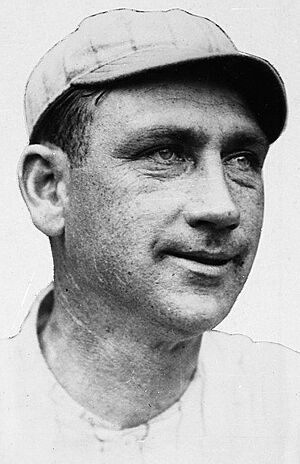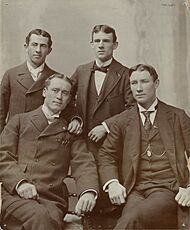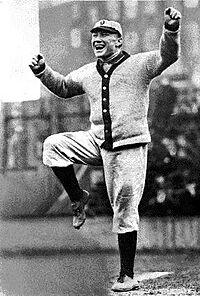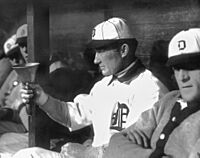Hughie Jennings facts for kids
Quick facts for kids Hughie Jennings |
|
|---|---|
 |
|
| Shortstop / First baseman / Manager | |
| Born: April 2, 1869 Pittston, Pennsylvania, U.S. |
|
| Died: February 1, 1928 (aged 58) Scranton, Pennsylvania, U.S. |
|
| debut | |
| June 1, 1891, for the Louisville Colonels | |
| Last appearance | |
| September 2, 1918, for the Detroit Tigers | |
| MLB statistics | |
| Batting average | .311 |
| Home runs | 18 |
| Runs batted in | 840 |
| Managerial record | 1,184–995 |
| Winning % | .543 |
| Teams | |
As player
As manager
|
|
| Career highlights and awards | |
|
|
| Induction | 1945 |
| Election Method | Old-Timers Committee |
Hugh Ambrose Jennings (born April 2, 1869 – died February 1, 1928) was a famous American professional baseball player, coach, and manager. He played and managed in Major League Baseball from 1891 to 1925.
Jennings was a key player for the Baltimore Orioles teams. These teams won the National League championships in 1894, 1895, and 1896. During these years, he was an amazing batter and shortstop. He hit for high averages, including .386 and .401 in two of those seasons.
Hughie was known for being a tough and fearless player. He wasn't afraid to get hit by pitches to reach base. In 1896, he was hit 51 times, which is still a Major League record! He also holds the career record for being hit by pitches, with 287.
Later, from 1907 to 1920, Jennings managed the Detroit Tigers. He was famous for his funny actions and loud shouts of "Ee-Yah!" from the third base coaching box. Hughie Jennings had to leave baseball in 1925 due to health problems. He passed away in 1928 and was later honored in the Baseball Hall of Fame in 1945.
Contents
Early Life and Baseball Start
Hughie Jennings was born in Pittston, Pennsylvania. His parents, James and Nora, were immigrants from Ireland.
When he was young, Jennings worked as a breaker boy in coal mines. This meant he separated coal from rocks. He started playing shortstop for a semi-professional baseball team in Pennsylvania. His talent quickly caught the eye of professional teams.
In 1891, he signed with the Louisville Colonels. He stayed with them when they joined the National League in 1892. In 1893, he was traded to the Baltimore Orioles.
Becoming a Star with the Baltimore Orioles: 1893–1899
Jennings became a true baseball star during his time with the Baltimore Orioles. The Orioles teams of 1894, 1895, and 1896 were some of the best ever. They had many future Hall of Fame players. These included John McGraw, "Wee Willie" Keeler, and Joe Kelley.

Even with so many great players, Jennings was made team captain in 1894. He had amazing seasons during these championship years. In 1895, he hit .386, scored 159 runs, and stole 53 bases. In 1896, he hit an even better .401, which was the second-best in the National League!
Jennings was known for being very brave. He would let pitches hit him to get on base. In 1896, he was hit 51 times, a record that still stands today. In one game, he was hit in the head by a pitch. He finished the game, but then passed out for three days.
He was also one of the best shortstops in the league. He led the National League in fielding percentage and putouts multiple times. In 1898, he hurt his arm, which ended his time as a shortstop. After that, he started playing first base.
Playing for Brooklyn and Philadelphia: 1899–1903
In 1899, Jennings moved to the Brooklyn Superbas with his manager, Ned Hanlon. Even though his arm was injured, he helped Brooklyn win National League titles in 1899 and 1900.
In 1901, Jennings was traded to the Philadelphia Phillies. His arm injury limited his playing time. He played only a few games for the Superbas in 1903, which mostly ended his playing career. He only played a few more times later as a manager.
Law School and Off-Season Work
While playing for the Orioles, Jennings also went to classes at St. Bonaventure University. After the 1899 season, he was accepted into Cornell Law School. He even managed the Cornell University baseball team while studying law. This made him realize he was good at managing teams.
Jennings didn't finish his law degree at Cornell. However, he passed the Maryland bar exam in 1905. He then started his own law practice. He worked as a lawyer in Baltimore and Scranton, Pennsylvania, during the baseball off-seasons.
The "Ee-Yah" Years: Managing the Detroit Tigers (1907–1920)
In 1907, Hughie Jennings became the manager of the Detroit Tigers. This team had future Hall of Famers like Ty Cobb and Sam Crawford. Jennings led the Tigers to win the American League championship three years in a row, from 1907 to 1909. However, his teams lost the World Series each time.
As the Tigers' manager, Jennings became famous for his funny actions. He would shout "Ee-Yah!" and make other loud noises. He would also wave his arms and lift his leg. This "Ee-Yah" shout became his trademark. Fans would even shout "Ee-Yah" when he came onto the field.
Behind all the fun, Jennings was a very smart coach. Another famous manager, Connie Mack, called Jennings one of the three greatest managers ever. One of his biggest challenges was managing the difficult but talented Ty Cobb. Jennings decided to let Cobb play his own way, trusting his judgment.
In 1912, during a game where fill-in players played for the Tigers, Jennings even came to bat himself once! He was known for his honest approach to the game. He managed the Tigers until the end of the 1920 season. His 1,131 wins were the most in Tigers history for a long time.
New York Giants: 1921–1925
After leaving the Tigers, Jennings joined his old friend John McGraw as a coach for the New York Giants. Jennings and McGraw were very close friends. Jennings was the best man at McGraw's wedding.
As a coach, Jennings helped the Giants win two World Series in 1921 and 1922. When McGraw became sick, Jennings stepped in to manage the Giants for parts of 1924 and 1925. His total record as a manager was 1184 wins and 995 losses.
Managerial Record
| Team | Year | Regular season | Postseason | |||||||
|---|---|---|---|---|---|---|---|---|---|---|
| Games | Won | Lost | Win % | Finish | Won | Lost | Win % | Result | ||
| DET | 1907 | 150 | 92 | 58 | .613 | 1st in AL | 0 | 4 | .000 | Lost World Series (CHC) |
| DET | 1908 | 153 | 90 | 63 | .588 | 1st in AL | 1 | 4 | .200 | Lost World Series (CHC) |
| DET | 1909 | 152 | 98 | 54 | .645 | 1st in AL | 3 | 4 | .429 | Lost World Series (PIT) |
| DET | 1910 | 154 | 86 | 68 | .558 | 3rd in AL | – | – | – | |
| DET | 1911 | 154 | 89 | 65 | .578 | 2nd in AL | – | – | – | |
| DET | 1912 | 153 | 69 | 84 | .451 | 6th in AL | – | – | – | |
| DET | 1913 | 153 | 66 | 87 | .431 | 6th in AL | – | – | – | |
| DET | 1914 | 153 | 80 | 73 | .523 | 4th in AL | – | – | – | |
| DET | 1915 | 154 | 100 | 54 | .649 | 2nd in AL | – | – | – | |
| DET | 1916 | 154 | 87 | 67 | .565 | 3rd in AL | – | – | – | |
| DET | 1917 | 153 | 78 | 75 | .510 | 4th in AL | – | – | – | |
| DET | 1918 | 126 | 55 | 71 | .437 | 7th in AL | – | – | – | |
| DET | 1919 | 140 | 80 | 60 | .571 | 4th in AL | – | – | – | |
| DET | 1920 | 154 | 61 | 93 | .396 | 7th in AL | – | – | – | |
| DET total | 2103 | 1131 | 972 | .538 | 4 | 12 | .250 | |||
| NYG | 1924 | 44 | 32 | 12 | .727 | Interim | – | – | – | |
| NYG | 1925 | 32 | 21 | 11 | .656 | Interim | – | – | – | |
| NYG total | 76 | 53 | 23 | .697 | 0 | 0 | – | |||
| Total | 2179 | 1184 | 995 | .543 | 4 | 12 | .250 | |||
Later Life and Legacy
Hughie Jennings' life included several serious accidents. He fractured his skull twice, once from a pitch and once from a diving accident. He also broke both legs and an arm in a car crash in 1911.
These injuries likely affected his health later in life. In 1925, he experienced health issues that made him leave Major League Baseball. He spent time recovering in North Carolina and Pennsylvania.
On February 1, 1928, Hughie Jennings passed away at age 58. He was later chosen for the Baseball Hall of Fame in 1945 as a player.
See also
- List of Major League Baseball career stolen bases leaders
- List of Major League Baseball player-managers
- List of Major League Baseball managers by wins
- 1909 Detroit Tigers season



